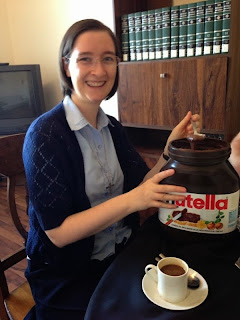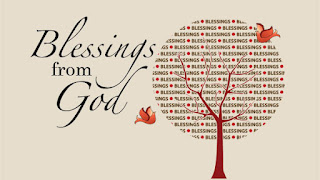Life is like a box of chocolates - you never know what you're going to get!
 Ok, the photo was crying out for a blog post! Nuns and chocolate! Yes, I confess, I am somewhat partial to chocolate as many of you know. However, it is a charismatic thing! Our religious family for many years has grown hazelnuts for the international company Nutella in Piedmonte, Italy and therefore we felt we had a quasi- obligation to support the company by consuming its products to create a demand. Oh the things one has to do in life! I recall my time in Alba and walking through the town when the breeze was just right and would spread the chocolate scent from the large factories right into your nostrils. What a delight!
Ok, the photo was crying out for a blog post! Nuns and chocolate! Yes, I confess, I am somewhat partial to chocolate as many of you know. However, it is a charismatic thing! Our religious family for many years has grown hazelnuts for the international company Nutella in Piedmonte, Italy and therefore we felt we had a quasi- obligation to support the company by consuming its products to create a demand. Oh the things one has to do in life! I recall my time in Alba and walking through the town when the breeze was just right and would spread the chocolate scent from the large factories right into your nostrils. What a delight! Believe it or not, there are many other religious connections with chocolate. We might not have this crucial ingredient of the good life if it weren’t for the important culinary work of a whole assortment of people in history—everyone from pagan Aztecs to Spanish nuns! "Food of the Gods," is the literal translation of the name Theobroma which is the name given to the chocolate tree and its genus by the great botanist Carolus Linnaeus.When the Spaniards began to colonize and catechise Mexico, they attempted to eradicate the pagan religion of the native Indians. As happened in other parts of the world, the Church successfully stamped out many pagan customs while keeping some of the best parts of the culture. The cults of various saints replaced those of pagan gods, and medicinal and other useful plants were renamed for Our Lord, Our Lady, or one of the saints, and continued to be used. In Mexico, the Aztec drink chocolatl was taken from its Aztec ceremonial use and retained by the Spanish as a tasty beverage and as a medicine.
By the late 1600's, the grand ladies of the land had become so fond of this frothy beverage that they were accustomed to having it served to them frequently, even in Church during Mass! As justification for their enjoyment, they referred to its medicinal use, and claimed it prevented fainting and "weakness" during the long ceremonies. One bishop considered it a blatant abuse, and forbad the practice. Drinking chocolate in church obviously broke the fast laws. The ladies, in retaliation, simply took themselves and their entourage to another church. The whole affair became a fearful scandal. Eventually, in 1662, Pope Alexander VII put a final solution to the affair when he declared " Liquidum non frangit jejunum." [Liquids (including chocolate) do not break the fast.] It is likely that this decision was based on the fact that chocolate, like so many other herbs, was considered to have medicinal qualities! Yet again, I concur!
Another interesting and very popular use of chocolate was invented by the nuns of a convent in Pueblo, Mexico. A visiting bishop was coming for Sunday dinner and the cook created a special dish in his honor with a peppery sauce over turkey, one of the native birds. At the last minute, she grated in some bitter chocolate, and called the sauce "mole." Because of its long list of ingredients, even the best of Mexican cooks today often use the sauce purchased ready-made for a delicious chicken dish.
That said, chocolate, in moderation is actually good for you! Apparently, by eating chocolate, you increase the serotonin levels in your brain. Serotin is the neurotransmitter that causes you to have a better mood. So, if you’re stressed out or upset, increasing your serotonin levels will not only help by increasing your mood, but they will also cause a significant decrease in anxiety. Chocolate, in particular dark chocolate, has other health benefits and is good for more than curing a broken heart. Plus you are helping many nuns and monks who make and sell chocolate as part of their mission of sustaining themselves and their religious communities. What can be better than that! Happy Nutella Day to you all!




Comments
Post a Comment